Comment Activer La Traduction Automatique Android
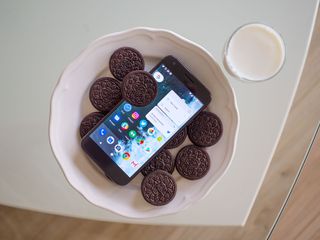
Some Android releases represent massive body of water changes for Google'south Os, overhauling technical underpinnings or introducing new design elements. Others are content to tighten upwardly the screws and add polish to an already well-established platform.
The new release of Android for 2017/eighteen — version 8.0 Oreo — fits somewhere in between those 2 extremes. Android itself is pretty stable at this point, so it's natural that wide, sweeping UX and functionality changes are less probable to happen with every new version. Yet although Oreo looks and feels a lot like the previous Android Nougat, contained within are myriad feature tweaks and low-level tune-ups that make Android more than mature and powerful.
With Oreo, your phone (or, let's be honest here, your next phone) will exist able to view videos in the foreground as you use other apps in the background. It'll become easier to continue track of multiple notifications from the same app, thanks to the new notification channels and notification dots features. Smarter text entry and autofill APIs volition take the tedium out of entering passwords and other sensitive info. And Google'southward "Projection Treble" should help phones aircraft on Oreo get faster updates to Android P and across.
That's aslope subtle visual and animation tweaks that make Android lighter, brighter and more than dynamic.
Google kept us guessing until the end when it came to the eventual nickname of Android eight.0, merely the software itself has slowly been coming into focus through the past v months of developer previews. And now, with the concluding, stable release of Oreo in our hands, we're set up to go stuck in.
This is the Android Fundamental review of Android viii.0 Oreo.
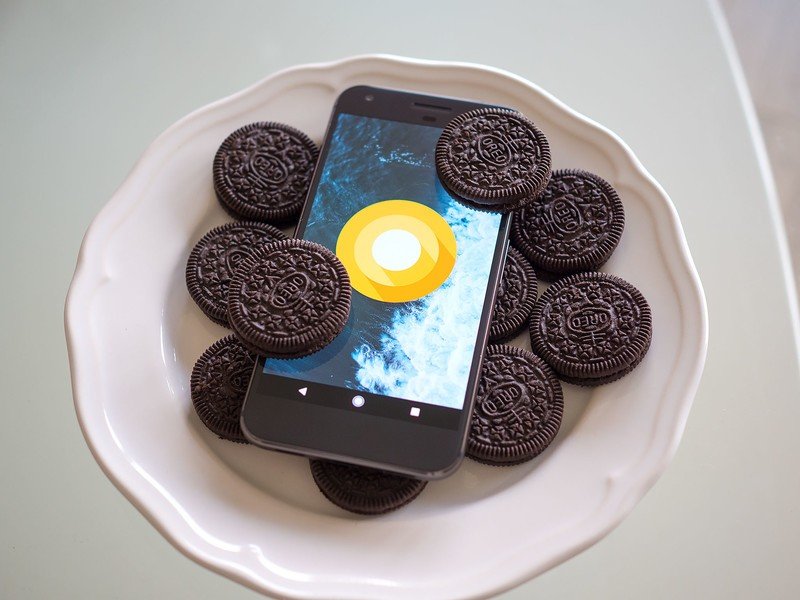
About this review
I (Alex Dobie) started work on review in early August 2017, having used Android O in developer preview form since information technology first landed in March. Most of what'south written here is based on the last developer preview, which is considered a about-final "release candidate" quality build. We're non expecting to encounter any meaning differences in the terminal release of Oreo for Pixel and Nexus devices, but nosotros will update this review should we notice any noteworthy changes.
This review isn't intended to be an exhaustive list of every little change Google has fabricated in Android viii.0, nor will we go into excessive particular on the developer-centric additions, like the introduction of Kotlin as a fully supported language. These changes are important, but this review is intended to give regular Android users an thought of what to await in the new version of the OS.
That said, nosotros're not writing an instruction manual here either. Instead, nosotros're presenting this review as an overview of the direction Google has taken Android in Oreo, zeroing in on major additions and offer a critique of how these affect the overall Android feel.
Bask!
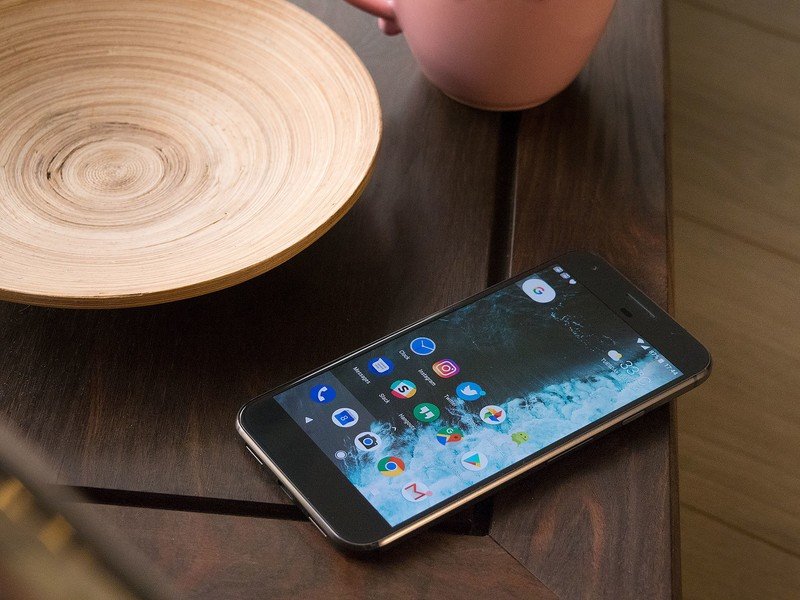
Look and experience
Virtually of us see Android through the lens of whichever manufacturer's UI we choose. This long-standing trend isn't going to modify in Oreo, then comport in mind that when you get 8.0 on, for example, your Galaxy S8, it'll wait a bit different to what nosotros're reviewing here on Google's Pixel devices.
Nevertheless, more manufacturers than ever — Motorola, Lenovo, OnePlus and HTC, to name a few — are using a nearly-stock Android UI right now. So in that context, the blueprint direction of vanilla Android continues to matter.
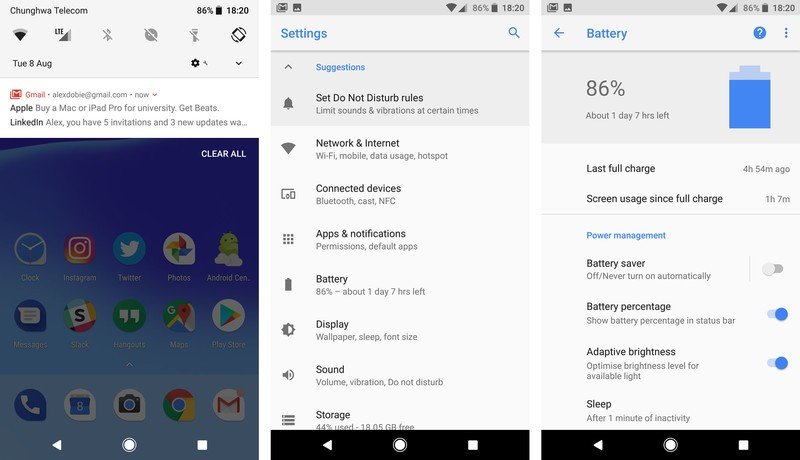
There'southward been no major visual overhaul in the new version of Android. In fact, the well-nigh striking visual difference is the brighter colour palette for the quick settings area in the notification shade. Information technology'southward now lite gray, not night grey, reflecting similar color changes in the stock Settings app. For the non-phone nerds among u.s.a. who own Pixels, these might well exist the only visual alter they notice. (As for whether it's good or bad, that's a matter of personal taste.)
Aside from this color change, in that location's been some pocket-size rearrangement to the quick settings panel, bringing the settings, user switching and edit shortcuts further down, making these easier to reach on larger phones. With the shift to an 18:nine aspect ratio in many popular flagships this year, improving reachability on taller phones is important.

The redesigned Settings app is the next well-nigh pregnant visual modify. The slide-out "hamburger" navigation panel added in Nougat has been removed, and instead Google has made navigation easier by redesigning each of the 13 sub-menus. Many of the major settings options are accompanied by icons, and Android at present does a ameliorate job of surfacing important items within each sub-bill of fare.
Android's settings are lighter, simpler to navigate and easier to reach.
The new battery settings page is a great example of this. Screen usage (screen-on fourth dimension) is shown correct upwards top, along with the time since your last full charge. Roll down a little, and your most battery-hungry apps are displayed.
You need to expect below the surface to spot many of the other visual changes in Android eight.0. For instance, Google has finally started bringing a sense of guild to app icons, with the new "adaptive icons" feature. Merely every bit Google pushed towards circular app icons in Android 7.1, adaptive icons lets phone makers change this cutout shape to what best fits their own visual style. (On the Pixels, you tin can choose between five cutout types.)

This means manufacturers similar Samsung, Huawei and LG, who like to employ their own icon cutout shape, have a more than reliable fashion to exercise this that doesn't result in bad, weird-looking icons for 3rd-party apps. The new icon style should likewise bring some uniformity to Android app drawers and home screens, which for a long time have been a jumble of mismatched shapes.
Oreo introduces a handful of neat new animations in the notification area.
Android's animations oasis't changed a whole lot in Oreo, just at that place are a couple of spritely new blitheness behaviors in the notification shade that add to the smooth of Google'south Material Design. Icons smoothly transition from the condition bar into their notification cards, then into the overflow area if yous have lots of notifications. And icons likewise juggle themselves around the status bar places every bit new alerts arrive, making the whole organisation feel more dynamic.
These are small changes, merely they go a long way towards making this of import area of the arrangement experience more than lively and dynamic.
Finally, information technology'due south worth mentioning a handful of upgrades to that most important of smartphone features, emoji! Android 8.0 adds a scattering of new emoji in Emoji 5.0, while redesigning the graphics themselves in a move away from the onetime-way "blobs". Going forward, Google'south emoji compatibility library volition allow developers to support new emoji on older Android versions (all the way back to 4.iv KitKat).

Meanwhile, behind-the-scenes font changes in Oreo let developers to customize the fashion emoji look in their specific apps, while making information technology easier for devs to use custom fonts in their apps. (Thanks to fonts becoming a total resource type in Android 8.0.)
Arguably, the Emoji Compatibility features in Google Play Services is the more than significant changes here. Nevertheless, system-level support for new icons, and more consistent-looking emoji, are also a big bargain. It's piece of cake to shrug off the importance of emoji, but they're an important part of communication for millions of people, and Google is doing the right thing by focusing engineering science effort on them, both in Android and Play Services.
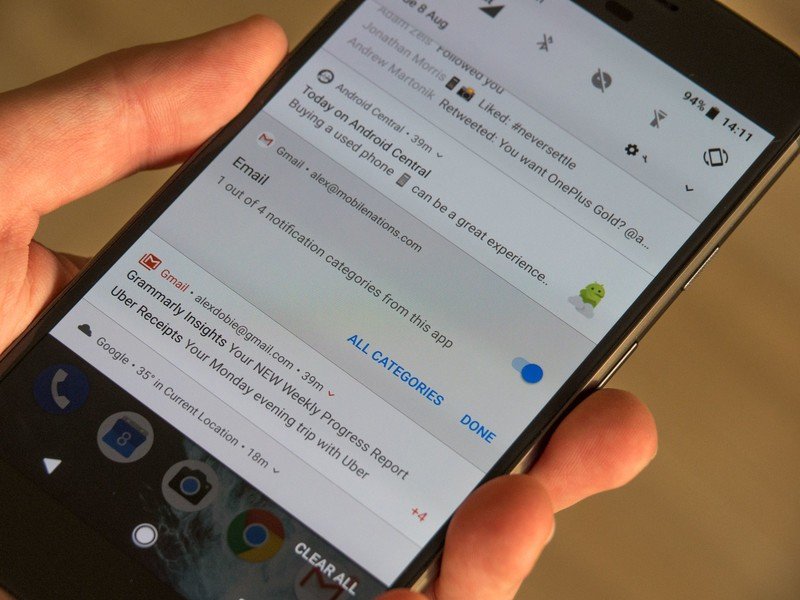
Android notifications were overhauled in Nougat, and Oreo brings a handful of smaller changes to make handling the daily firehose of alerts a picayune easier.
The big new thing is notification channels, a new feature which brings categories of notifications to apps, making it easier to manage and filter different types of alerts from the same app. A social app, for example, might have channels for direct messages, condition updates, likes or other interactions.
And you can and so choose how yous're alerted for notifications in each of these channels — sound, vibration, or LED — or even block notifications from some channels altogether. Long-pressing on a notification lets you see and configure its notification channels — just as in older versions of Android, you could choose to allow or block notifications.
There'southward a sure amount of micro-management involved in getting to grips with notification channels.

There's a certain amount of micro-management involved here, and it's questionable whether most users will fifty-fifty be aware of notification channels in the short to medium term. Google is hoping to speed this process along past requiring notification channel support when apps target Android 8.0 on the Play Store.
And that'due south the other caveat here — it'due south going to take fourth dimension, and a lot of individual app updates, before we know how successful this feature is going to exist. Perchance notification channels will be genuinely useful. Or peradventure we'll all be too lazy to bother with them.
Speaking of laziness, Android 8.0 also allows you to snooze private notification groups for 15 minutes, xxx minutes, 1 hour or two hours, by swiping right and hitting the clock icon. The use case here is pretty obvious — this should be a helpful manner to dismiss a notification you don't need to bargain with right away, without getting rid of it permanently.
Elsewhere, media player apps like Google Play Music, YouTube, and eventually others, can introduce a splash of color to their notifications, drawing upon the primary colors of anthology art, video thumbnails or affiche art. It'southward a somewhat contentious feature, with some commentators arguing that it adds unnecessary visual clutter. The faded transition into album art is a niggling distracting, peculiarly when brighter colors are introduced, but information technology's also arguable that this helps set media controls apart from other miscellaneous alerts.
Colorful playback notifications jump into the foreground, as persistent notifications fade into the groundwork.

Simply as media controls are beingness pushed more than into the foreground, persistent notifications — for instance, from Maps, the Google app, a Wi-Fi hotspot, USB connection or whatsoever other process that might be running in the background — are being de-cluttered. These now shrink down to a shorter notification card in a slightly darker shade, setting them apart from more than important alerts. If you need to see more info, you can expand them similar whatever other notification.

The changes to Android'south notification setup are small but numerous, and they aren't confined to the notification shade itself. Ambient Display, first introduced fashion back on the Nexus half dozen, has seen its biggest overhaul thus far in Android 8.0.
The primary Ambient Display surface area actually shows yous less information than it did in Nougat, with only the time and a series of icons appearing when the phone is raised. The other side of that coin is that individual notifications at present wink upwardly in a more than user-friendly way.
Notification popular-ups on the Ambience Display are larger and easier to read, and if yous take the option enabled, a double-tap is all information technology takes to open up the master lock screen.
Balancing information density and glanceability is ever tricky, but Google manages a reasonable blend of both in Oreo.


And last only not least, in addition to the notification shade, lock screen and always-on display, Android 8.0 allows launchers to show you lot private app notifications through the notification badges characteristic. Apps with a pending notification will brandish a colored dot, and long-pressing to open up the shortcut menu will show notifications alongside app shortcuts, consummate with the ability to swipe to dismiss.
That'southward not the only new fox hiding backside the app shortcut menu in Oreo — a new widget shortcut push button frees users from long, cumbersome widget menus, with an easy mode to see all the widget from a item app.
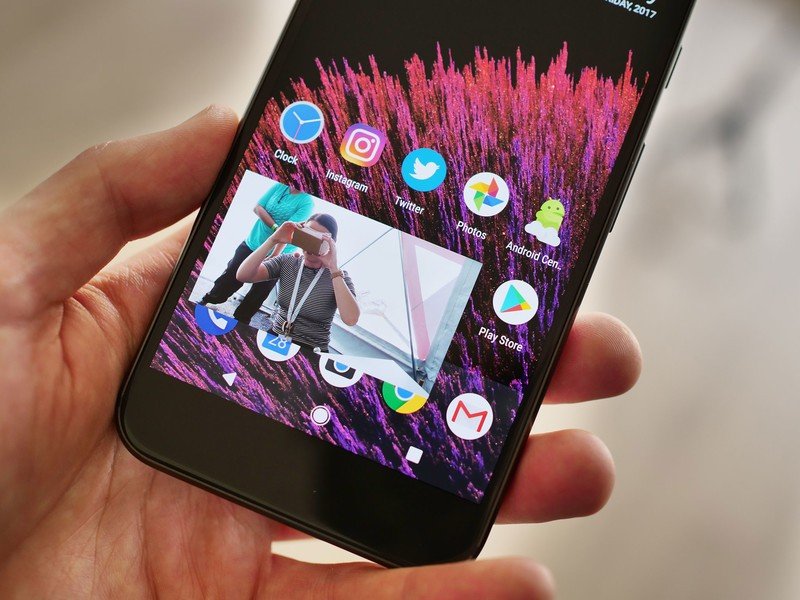
Picture-in-Picture show
Motion-picture show-in-picture mode was actually introduced in Android 7.0, but simply for Android Television devices. Version 8.0 brings information technology to phones and tablets, introducing a potentially huge feature for owners of extra-large phablet-class devices.
PiP manner varies a piddling depending on how the programmer implements it, simply basically this feature lets y'all outset a video from within one app, then hit the home fundamental to shrink it down into a smaller floating window with its own playback controls. Y'all can resize and move it around the screen in the foreground, while opening and using other apps as normal in the background.
Information technology's like to multi-window, introduced as standard in Nougat. And while you can use multi-window to separate the screen between video and other apps, PiP is a much more elegant approach.

Motion picture-in-movie fashion finally arrives on mobile devices — just will content providers make users pay to apply it?
Like many Android 8.0 features, we're going to accept to wait for programmer to update their apps to take reward of PiP. And every bit always, some platform holders (or their advertisers), and rights holders (or their lawyers) may object to allowing background playback in some instances. We're already seeing background playback gated off behind a virtual paywall in YouTube, where a YouTube Ruby-red subscription is required to play videos in the background.
In any case, Oreo lays the technical foundations for this feature on phones and tablets. And with the possibility of more Google-branded Android tablets alee — and even more Android-enabled Chromebooks — there are heady possibility for users and developers alike.
Smarter logins and text entry
Everyone hates entering passwords — the tedium of countersign entry has spawned an entire manufacture of countersign managers. But these still require a lot of frustrating copying and pasting.
So in Oreo, Google has tackled the countersign pain point on two fronts. Firstly, "Autofill with Google" can help you sign into accounts on your phone using information already stored in your Google business relationship — all with a single tap. For instance, if you've signed into Twitter on the web through Chrome, Google can then use these saved credentials to help you sign into the Twitter app on your phone.
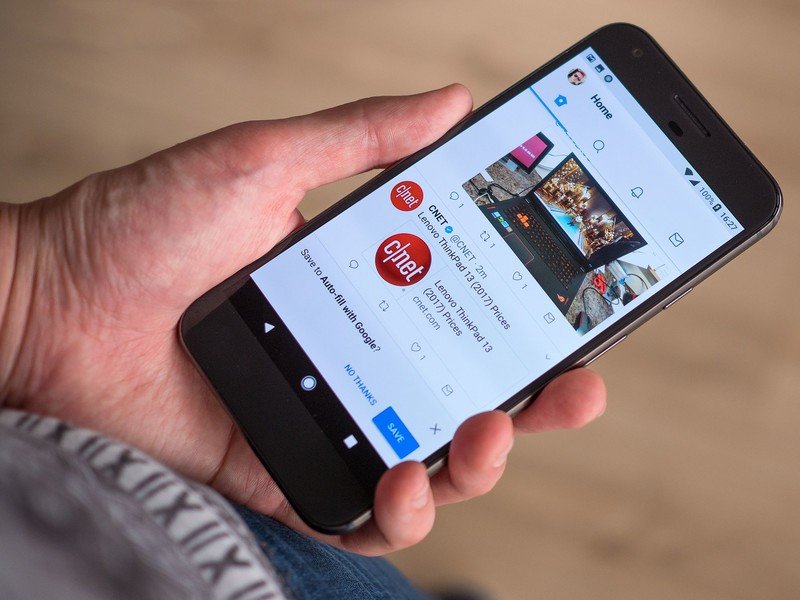
Android Oreo is the showtime of the end for password entry on phones.
If you've already signed upwardly to a password manager service (and they've updated their app to work with Android 8.0), you'll be able to pull in passwords from their app automatically, with whatsoever hopping back and forth, or copy-pasting between text fields.
This characteristic certainly takes a lot of the hurting out of setting up a new Android devices, and from Google's perspective, the benefits work both means, giving Android users an additional reason to employ Chrome for their desktop web browsing.
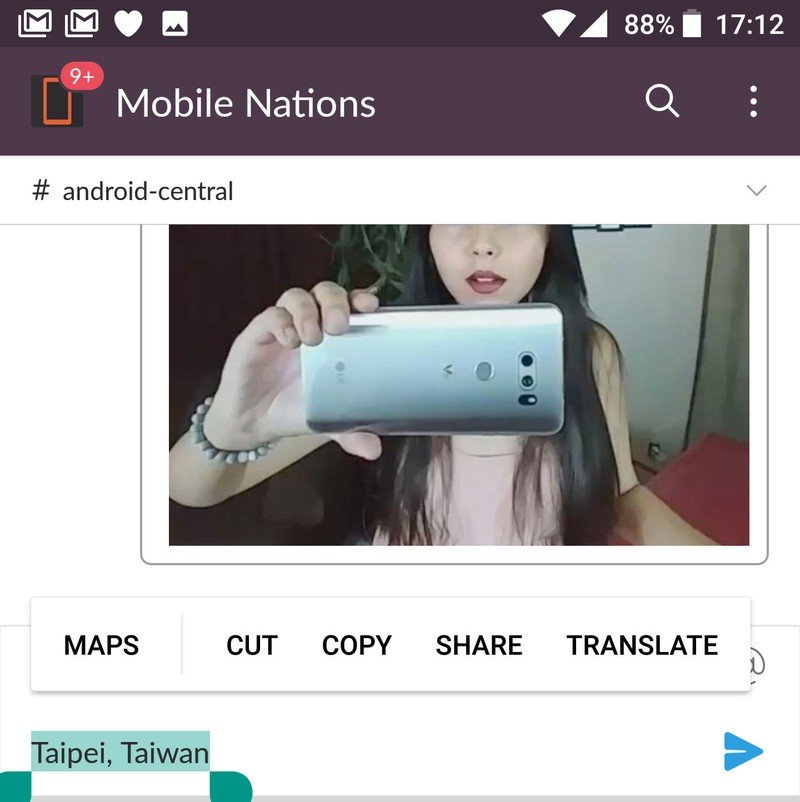
Taken to its logical extreme, Android eight.0's password features could entirely practise abroad with having to enter passwords on a mobile device. (With the exception of your Google password and two-factor code, of course.) But similar many of Android's most convenient features, you'll need to be comfortable with giving Google all this data in the showtime place to reap the benefits.
On a related notation, Android is also getting smarter well-nigh how it handles specific kinds of information in text fields. When highlighting text, Google's machine learning figures out what kind of data yous've selected and offers relevant contextual options — for example, a shortcut to the Dialer app for phone numbers, or Google Maps for addresses.
This is supported in Google Chrome on older versions of Android, but it'southward great to see information technology beingness introduced throughout the OS in Oreo.
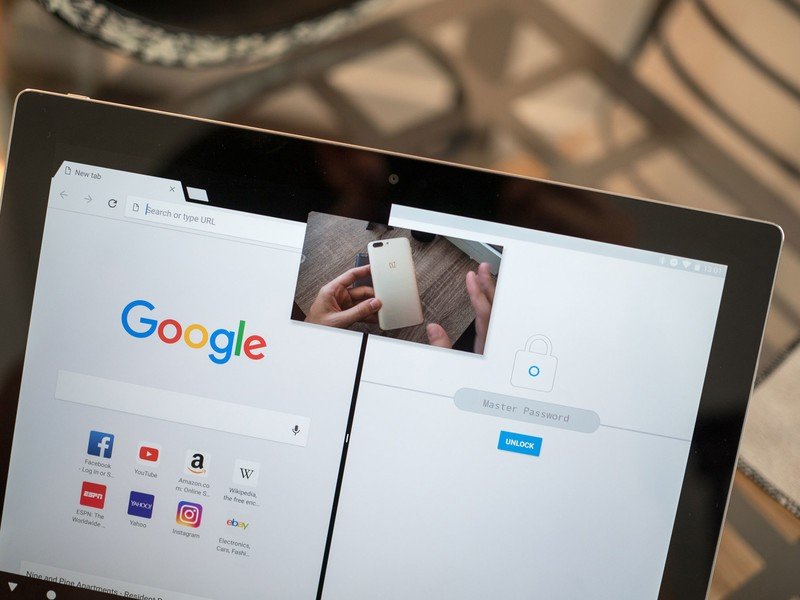
New features for convertibles
Despite the moribund state of the Android tablet market, Oreo provides clues that Google nonetheless intends to push into the convertible space — either through Android as we currently know it, Chrome OS running Android apps, or something else entirely.
Android 8.0 brings new life to the soonhoped-for-retired (nonetheless still criminally overpriced) Pixel C tablet. On top of the new multitasking interface introduced for tablets in version 7.i.two, Android eight.0 adds a new system for keyboard shortcuts inside Android apps, making it quicker to go around apps and menus where information technology's not user-friendly to bear on the screen. That's particularly useful considering that a vast bulk of a big tablet'southward life is spent attached to a keyboard.
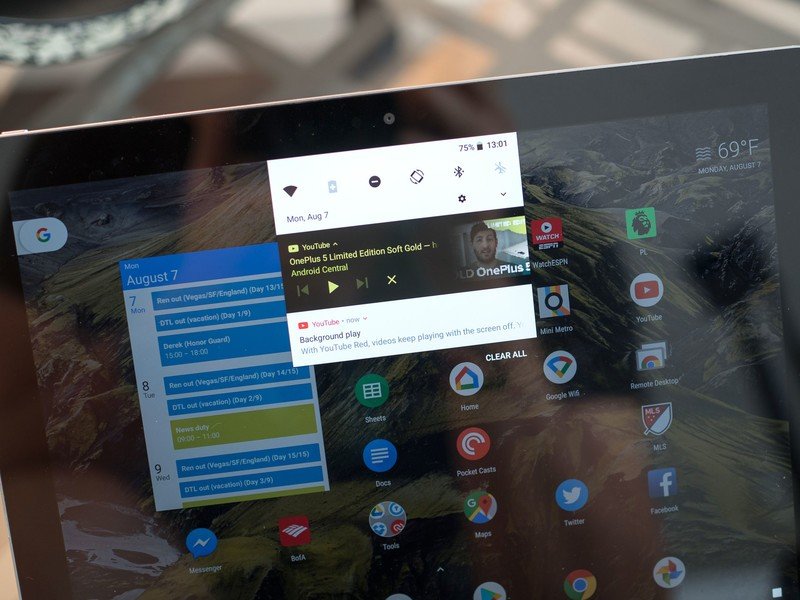
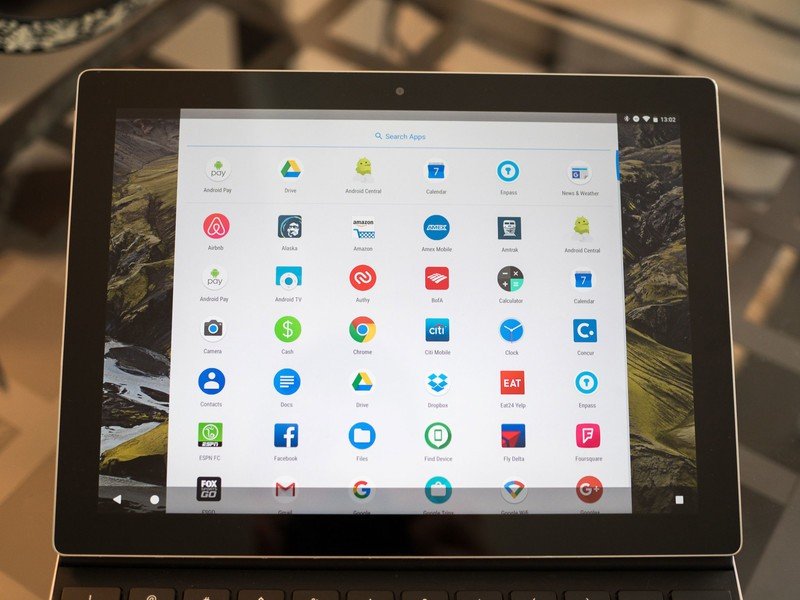
No more awkwardly resizing that Netflix window to fit alongside your other apps.
More than broadly, the Pixel C, and Chromebooks in general, should benefit from the new pic-in-motion-picture show way, which will be particularly useful on a laptop, tablet or convertible. (No more awkwardly resizing that Netflix window to fit alongside Chrome, Twitter and other apps.) It'south not a full desktop window organisation, but instead brings Android tablets in line with where the iPad is correct at present.
Also noteworthy: New audiovisual improvements that should assist make Android tablets more than appealing to content creators. Support for wide-gamut colour in apps (such every bit DPI-P3, Adobe RGB and Pro Photo RGB), aim to brand Android tablets a better fit for photographers, while the new AAudio API will reduce audio latency, bringing Android a footstep closer to taking on GarageBand on the iPad.
Android still has a long style to go earlier it tin challenge Apple tree and Microsoft on tablets and convertibles, only the new features in Oreo shouldn't be discounted. Every bit ever, the critical issue with Android tablets is still app support, where very few apps — even Google's own — properly back up large, landscape displays. Android viii.0, for all of its improvements, can't really practice anything to fix that.
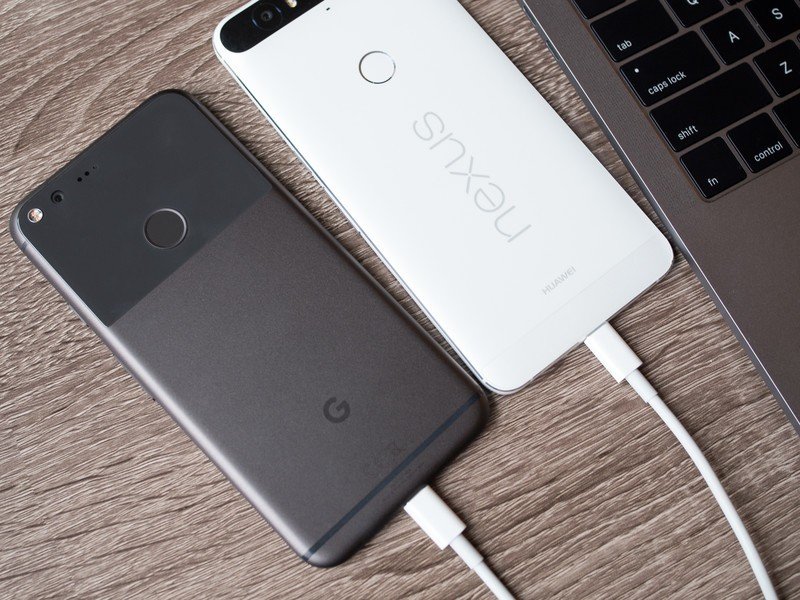
Under the hood: Background limits, meliorate bombardment life, faster OS updates
Out-of-control apps running in the background accept long been the number one reason for poor bombardment life on Android phones. And now, building on the "Projection Doze" and "Doze On-The-Go" enhancements in Android 6.0 and 7.0, version viii.0 makes it harder for desperately-behaving apps to run savage over your device's battery.
In Oreo, Google has introduced even more limits on what apps can do while they're not in the foreground. Broadcast limitations in the new version mean that (with a few exceptions) apps in the background can't react to broadcasts (things happening on the device) that don't specifically target them. Google is using these restriction to nudge developers towards Androids task scheduler feature, introduced in Lollipop, which manages groundwork tasks in a way that's easier on your battery.
As the possessor of a device on Android viii.0, you don't need to practice anything to take advantage of the battery life (and performance) benefits of tighter background controls. Over the past couple of weeks using the concluding Oreo programmer preview, I tin can't say I've noticed whatever huge difference in battery life on my Pixel Xl compared to Nougat. (Then over again, I've always found that phone's standby battery life to exist solid.)

Oreo makes it harder for misbehaving apps to devour your battery.
Some other major pain point beingness addressed in Android 8.0 is Bone updates. Through its new Project Treble initiative, Google is has created a modular structure that hardware companies can use to split out their ain customizations from the core Os. The idea is this will make it easier to push out firmware updates without completely reinventing the wheel. This isn't a panacea for Android'due south update woes, but it should significantly reduce the workload required to update a phone aircraft on Android 8.0 to a hypothetical version 8.1 or ix.0, in add-on to speeding up the rollout of security patches in the interim.
It's going to take years, not months to judge the success (or otherwise) of Google'south new Project Treble.
It's going take fourth dimension to judge how much of a success Project Treble has been. Air conditioning understands that information technology'due south non a hard requirement for OEMs shipping a phone on Android 8.0, but that Google will push device makers towards using Treble rather than continuing in the one-time way.
Scout this space.
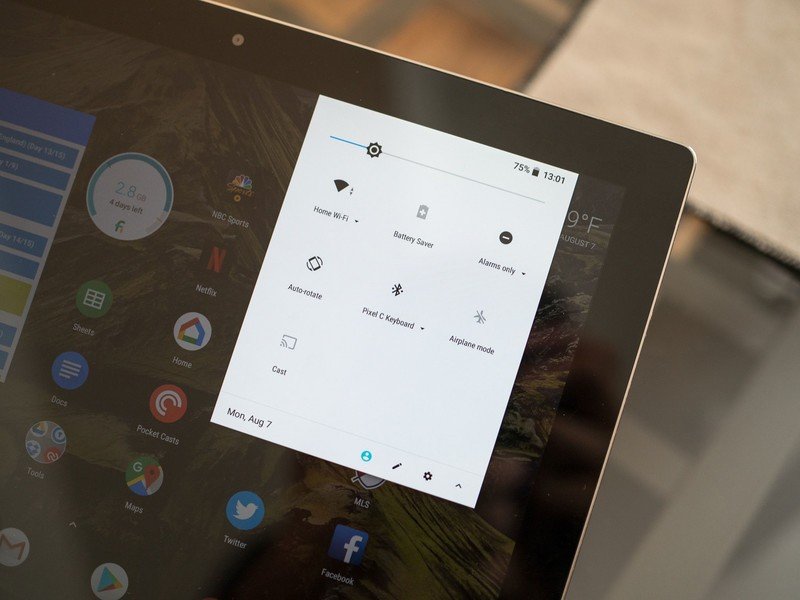
Android 8.0: The Bottom Line
It's difficult to go excited about any single feature in Android 8.0 Oreo, even for smartphone nerds like us. That's very much a production of where nosotros are in the OS'due south lifespan right at present, but information technology as well speaks to the fact that Google is using this release to target specific areas — notifications, autofill, picture-in-picture, groundwork battery life, Project Treble — as opposed to doing whatever major work on the user-facing side of Android.
Every bit a result, Oreo is the sum of many smaller changes that make the OS easier to employ, with ameliorate functioning, fewer pain points and added convenience. Android yet feels similar Android, only in 8.0 it'southward more polished than always.
Oreo is free from the early wonk that affected the starting time round of Android 7.0 releases.
That said, Nougat is still more than good plenty for most folks, for the fourth dimension beingness. And as Google and its partners proceed to roll out security updates independently of Bone updates, being out of stride with the latest platform version doesn't hateful you're open to malware. That'south merely as well, considering if by years are any indication, nosotros'll be well into 2018 before Oreo hits double figures in terms of its Android ecosystem share.
In the grand scheme of things, Project Treble could turn out to be the most pregnant addition in this version of Android, as Google finally picks abroad at the technical barriers that go on so many phones on older versions of the Bone. At the same time, the introduction of picture-in-picture show mode, as well as refinements to keyboard navigation, meet Android shuffling closer to desktop/convertible OS status.
On the surface, this is a fairly safe release cycle for Android — evolution, not revolution. And true, well-nigh of us volition see Oreo for the first time on a new 2018 handset, unless at that place's an unexpected rush amid OEMs to update existing devices. (That's almost certainly not going to happen.)
Only despite the lack of an exciting headline feature, Oreo is still an of import update. More importantly, it appears to be free from the woes which affected early Nougat firmware for the Nexus 5X and 6P this time final twelvemonth. And for Pixel and Nexus owners lucky enough to be on the early on release track, they'll be amidst the first to feel the near stable and capable Android release in years.
Andrew Martonik and Jerry Hildenbrand contributed to this review.
Alex was with Android Central for over a decade, producing written and video content for the site, and served as global Executive Editor from 2016 to 2022.
Comment Activer La Traduction Automatique Android,
Source: https://www.androidcentral.com/oreo-review
Posted by: williamswifigh75.blogspot.com


0 Response to "Comment Activer La Traduction Automatique Android"
Post a Comment